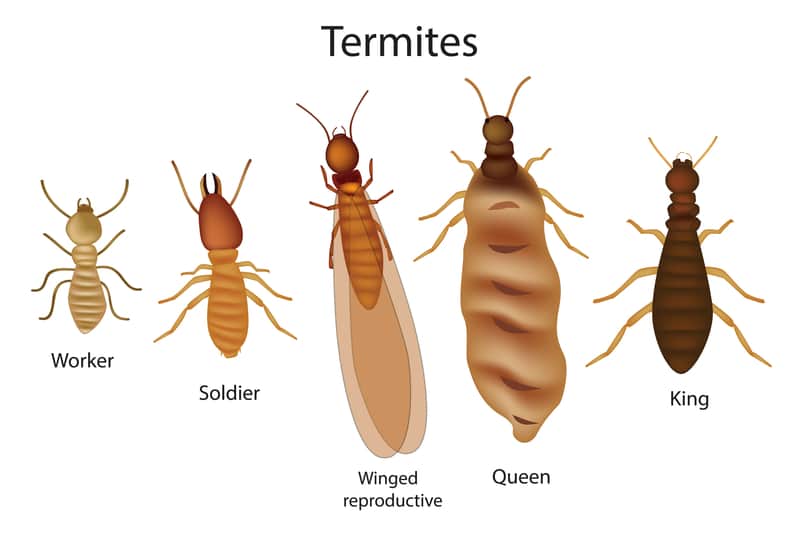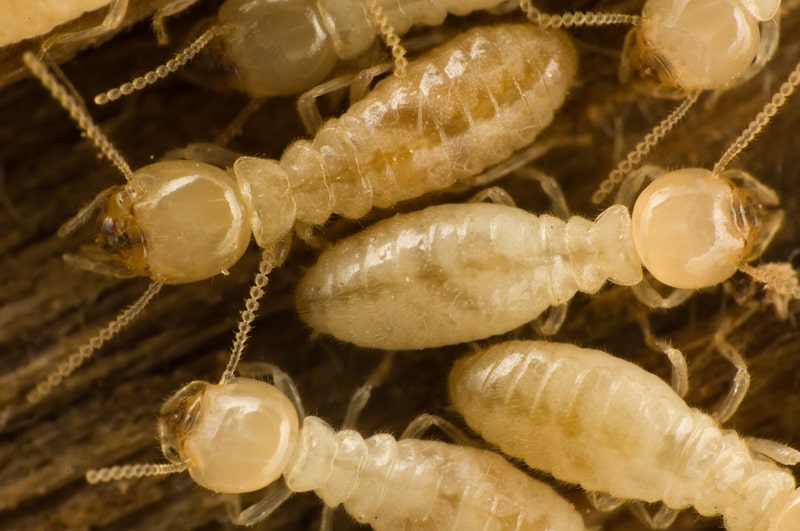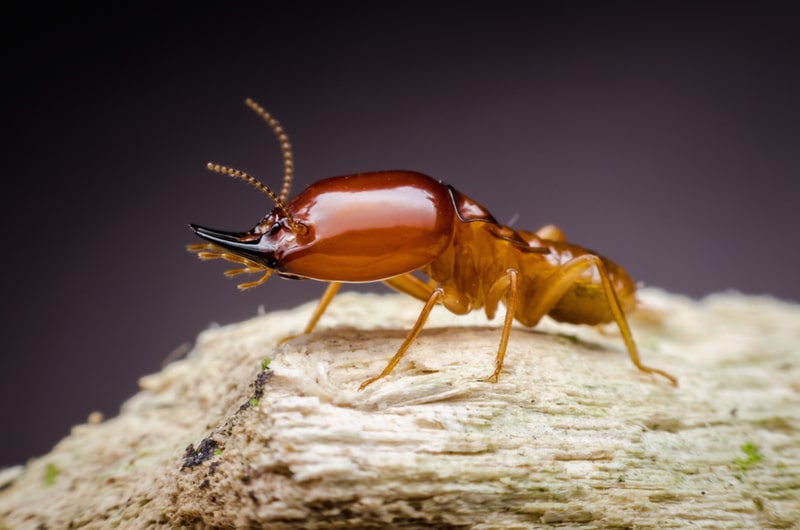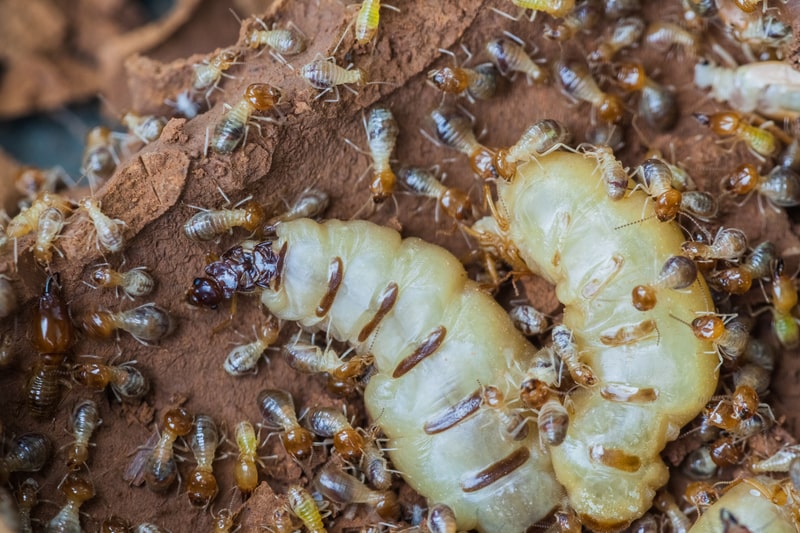
Contributed by: Doug Webb
Updated on: October 28, 2022
Termites are some of the most destructive insects that homeowners have to worry about. They can feed on your house, burrowing into the wood and potentially threatening the structural integrity by feeding on the building itself.
In most instances, it may be several years after the termite colony has taken up residence in your home before you even realize you may have a serious problem on your hands.
So how do termite colonies form, and what should you look for when you're checking for evidence of termites in your house?
Termite castes
Like many nesting insects, termites are social creatures. They form large colonies based on a hierarchy or caste structure that is comprised of three main groups:
- Reproductives
- Workers
- Soldiers
Each caste or group takes care of a different job within the colony.

A typical termite colony will have a single pair of reproductives: the king and the queen. The termite king and queen produce pheromones, scents that signal nesting and mating, that spread throughout the colony to prevent the worker termites from becoming reproductive adults.
Depending on the species of termite, a colony will contain several forms or castes, including immature termites, workers, soldiers, nymphs and reproductives.
Workers and soldiers are sexually immature males and females. Soldiers defend the colony and workers care for the king, queen and termite nymphs.
The queen starts the colony and lays all the eggs until the colony reaches a certain size. She then allows some of the immature termites to develop into secondary queens which lay the additional eggs needed to keep the colony thriving. Let's delve more into the inner workings of a termite colony, exploring the roles within the hierarchy and how they interact with one another.
Worker termites
In termite colonies, workers termites are wingless and soft-bodied. They comprise the largest group within a colony, and are most frequently seen when infested wood is disturbed.

In some termite colonies, it is actually the immature termites or the sterile adults that are the workers instead.
The workers take care of eggs and immature termites (nymphs), forage for food, feed and groom nest mates and take care of the building and maintenance of the colony structures. They feed on cellulose, which is an essential component found in wood and grass. In nature, they're helpful in the breakdown of dead and decaying materials. However, when worker termites seek to eat the wood in your home, they create devastating problems.
You can distinguish worker termites from other termites by their color and size. Worker termites are pale or white, have rounded heads and bodies and straight antennae. They are smaller than the colony king and queen.
The soldiers
Soldiers are the protectors of a colony. They vary greatly in appearance from other members of the termite colony and are typically larger.
They also have darker heads and larger mandibles than workers. Soldiers guard the termite colony and defend it against predators.

The reproductives
Reproductives are the termites that procreate. Reproductives include the king termite, queen and the winged alates. They look different from the others in that they often have darker bodies.

The alates
Alates are sexually mature males and females that develop wings and fly from their original colony, hiving off to start their own colonies.
As the alates fly, they pair up into couples. Once landed, they shed their wings and head underground to become king and queen of a new colony.
The termite queen
The queen is largest in physical size, attaining mass several times that of workers. Her main function is to lay eggs, sometimes thousands in a single day.
Once the colony develops, there are some types of termites that have supplemental reproductives to help her. When the original queen cannot keep up with egg production needed to sustain or grow the colony, the supplemental queens will begin to produce eggs.
In some termite colonies, other individuals are capable of replacing kings or queens if they die. But it's the queen's job to control the population and manage the growth of the colony over time.
Before mating, the new king and queen burrow into the ground, digging a royal chamber in the moist soil. The termite king and queen seal their nest with soil, saliva and their own waste. Then the king and queen mate.
After mating, the new king and queen spend the rest of their lives underground being fed by the worker termites. The new queen lays her first batch of 6 to 12 eggs within a few days or weeks of mating, establishing a new termite colony. A mature queen can lay thousands of eggs each year.
The termite king
The termite king is the other half of the reproductive equation. He helps keep the colony viable and strong. He's smaller than the queen and typically remains about the size of an average worker termite. The main distinction lies in his darker coloring.
The life of a king termite is spent entirely underground. Beyond supporting colony growth and structure, the role of the termite king is largely unknown. But it is clear that the colony wouldn't grow and thrive without his help. While he doesn't wear a crown or have a throne, the termite king is high priority in his colony, second only to the queen.
The new branch
Subterranean termite colonies establish a new colony by swarming.
The new colony has the capacity to produce its own reproductives and develop rapidly as an independent colony. Unfortunately, those colonies can pop up just about anywhere on your property, not just near the original colony.
Termites can take up residence in your house, underground or in your landscaping, and they're sometimes able to establish themselves without maintaining contact with their original colony.
Subterranean termite colonies
Eastern subterranean colonies are the most common species of termite in the U.S. This is because termites love the cool, humid environments found deep beneath the surface.
Once underground, subterranean termites have the appropriate humid conditions to thrive. But they exist on cellulose, the organic compound found in wood and plant matter. If wooden deck posts, steps or door frames touch the ground, termites can get easy access from their underground homes to a food source. But they can also access the wood in your home via cracks in your foundation or by building exterior mud tubes that act as highways for workers to travel from the colony to the wood food source.
Household termite colonies
Though underground nests are the most common, termites can and will occasionally form nests in your house. It all depends on the species common in your area and the risk factors inside your house. Aside from subterranean termites, others that can damage your home include:
Drywood termite colonies
Unlike subterranean termites, drywood termites do not need to live in moist soil to survive. As their name suggests, they ingest dry wood.
Drywood termite colonies are significantly smaller than their subterranean counterparts. A drywood termite colony may only consist of roughly 5,000 or fewer members, while a subterranean termite colony can top out at close to two million members. Another key difference is that drywood termites do not have a true worker caste. Rather, termite nymphs take on the role normally reserved for the worker caste.
Drywood termites may start their colonies by taking up residence in a fallen log or dead tree on your property. In time, they may expand their reach, moving into the lumber within your house. There, they can cause damage to your home.
Dampwood termite colonies
Dampwood termites prefer moist, humid or even fully wet environments. When they're forming a termite nest in your home, they look for damp areas. This could be wood that's been damaged by a leak or wood in basements and crawl spaces where humidity levels keep the wood moist.
Like drywood termites, dampwood termites can live completely inside the wood that they eat through. Like their drywood termite cousins, they do not have a worker caste and their nymphs take on the task of creating tunnels and feeding the rest of the hierarchy.
What makes dampwood termites unique is that they are harder to detect due to their habits, allowing them to continue their voracious feeding on the wood of your home for years before you're aware of their presence. In order to maintain optimum, humid conditions in the wood, they use their fecal matter (or frass) to seal up any holes in wood.
Although dampwood termites are among the largest species of termites in the U.S., their colonies are among the smallest in terms of members.
Formosan termite colonies
Formosan termites are a type of subterranean termite that originated in Asia. Today, Formosan termites can be found in the Southeastern portion of the U.S., as well as in Hawaii. Although these termites initially make their home in the soil, they can find their way into a home via any wood that meets the ground, such as a foundational structure, joints, or cracks.
Another distinguishing feature of Formosan termite colonies is that the winged alates of this species are able to establish a colony without making contact with the soil, if the conditions are right. For instance, they can hive off and start an aerial colony if there are places for them to enter, along with ample food and water. For instance, a flat roof that collects rainwater can create optimal conditions for a Formosan colony to thrive.
In terms of sheer numbers, Formosan termite colonies can have between several hundred thousand and 2 million members. They are aggressive feeders, and a colony can cause severe structural damage to a home.
How do termite colonies expand?
Established subterranean termite colonies typically mature in about six to seven years and after that they are ready to expand. At that time, alates (swarmers) are produced. Termite swarmers are male and female reproductive members of the colony and can be brown-black to pale reddish-brown in color depending on the species. They're generally about 1/4" to 3/8" long, with pale or smoke-gray wings. During late winter or early spring, male and female swarmers leave their nest on a mating flight with thousands or even millions of other winged termites.
The swarmers are poor fliers, so they usually only fly a few yards from their old nest. However, they may be carried great distances by the wind. Winged termites can land on the roofs of buildings and sometimes move inside. Many of the alates are eaten by frogs, lizards, birds or spiders during this mating flight, so relatively few alates survive to find nesting sites, reproduce and form new colonies. The termite colonies produce many alates so that at least a few survive the mating flight.
What happens during the flight?
Male and female swarmers pair up during the mating flight. The female alate releases a pheromone to attract a male for nesting and mating. The winged termites shed their wings shortly after landing and spend the rest of their lives without flight. The male and female termite couple look for a nesting site near moist soil.
How big is a termite colony?
Accurately determining the size of a termite colony can be a challenge according to the Mallis Handbook of Pest Control by Arnold Mallis. However, estimates suggest the population of termite colonies can be anywhere from 10,000 to millions.
As the colony increases in size, the queen may allow more non-swarming reproductives to help produce enough workers to feed the colony.
What does that mean for your home?
While small in size, termites can cause significant damage. One colony can forage an estimated 78 linear yards. Some termites forage for even greater distances. On average, a colony of Formosan termites, which is less common than a subterranean colony but more destructive, can forage for the length of an entire American football field. Combined, termites are estimated to cause over $5 billion of damage in the United States each year.
If you see winged termites or other evidence of termites inside or near your house, you probably have a termite colony nearby. That means it's time to call your Terminix® specialist for a termite inspection.
Termites differ from many other insects in that they live in organized social colonies. A termite colony can vary in size from only two termites (a king and queen) to a million or more. The sooner you can deal with the infestation, the better.
Professional termite control is essential
Termite infestations can happen anywhere, at any time. It doesn't mean you're neglecting your house or that there's something inherently wrong in your property. But it does mean you'll want to take care of the problem as quickly as possible.
Contact Terminix to schedule a free termite inspection and let our termite control professionals create a custom treatment plan for your home. Whether you're dealing with an active infestation or simply want to keep termites from becoming a problem in the first place, our team can help.


